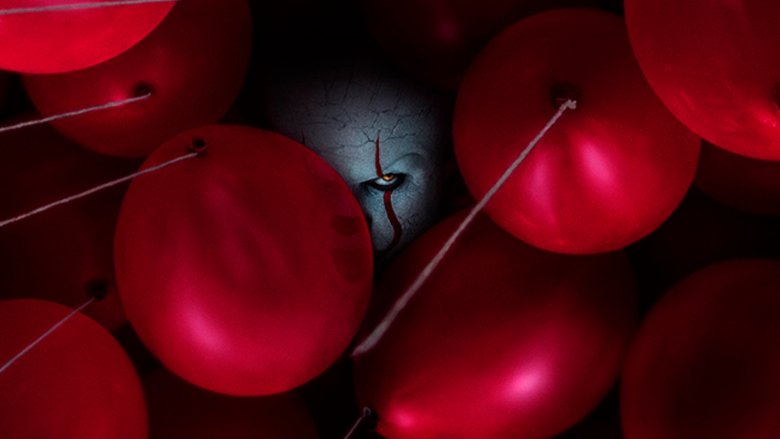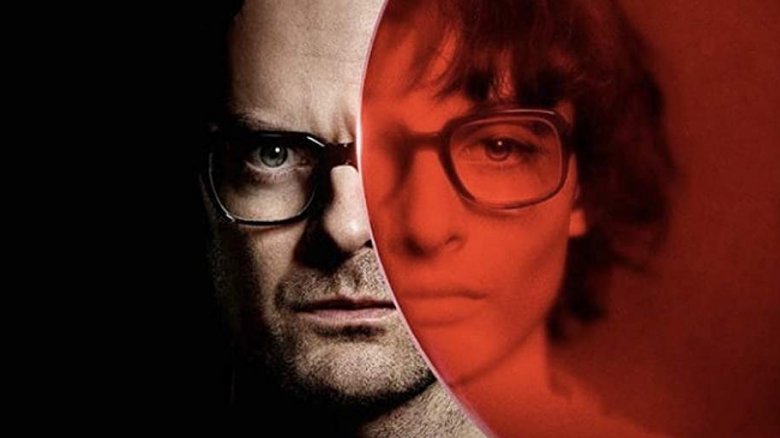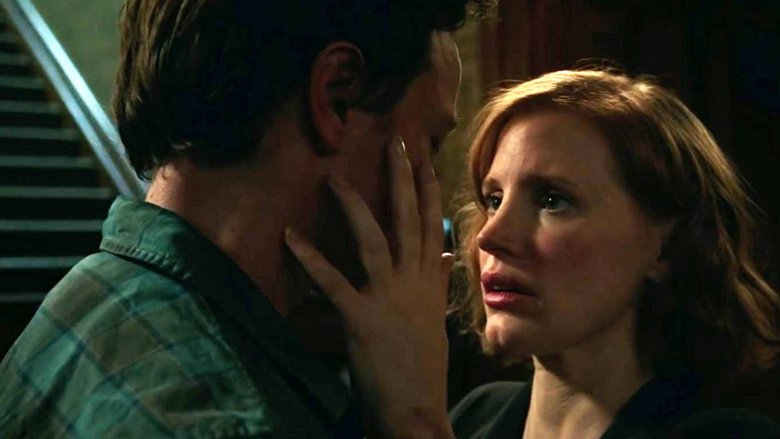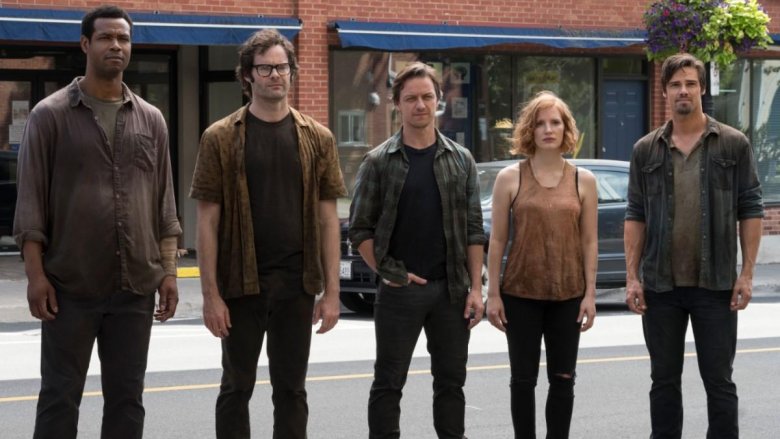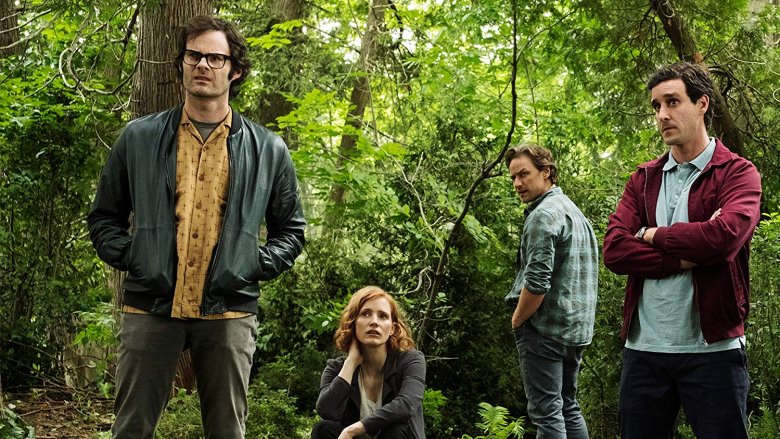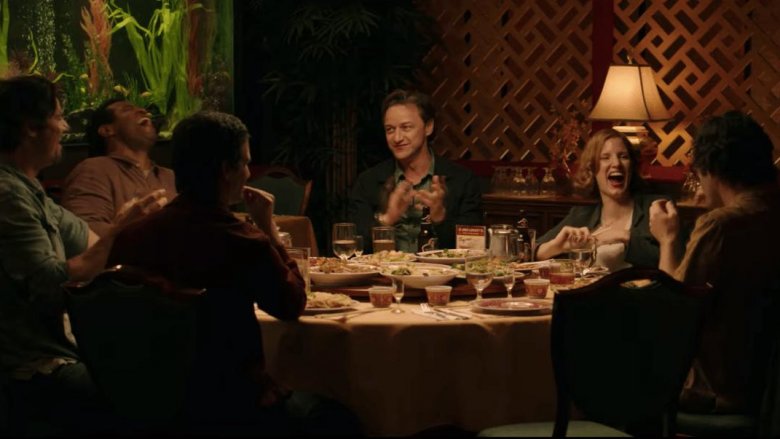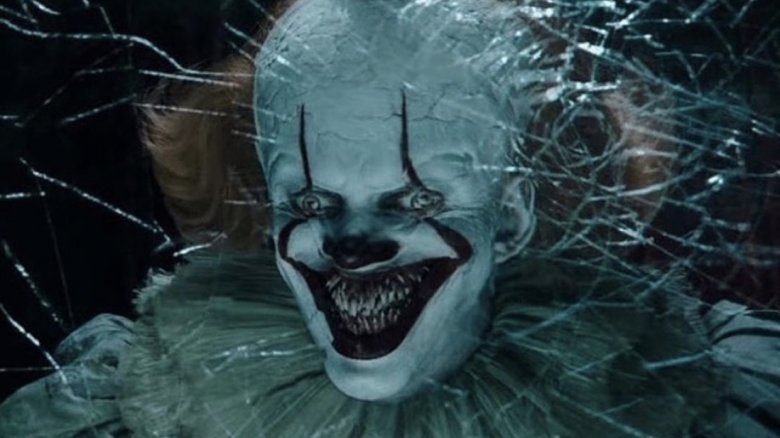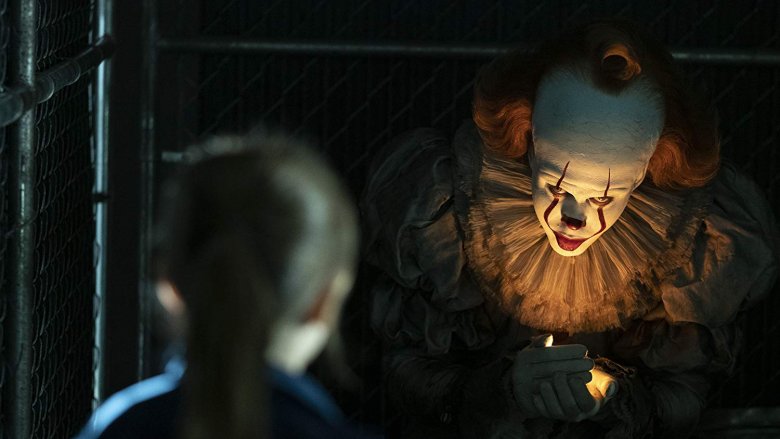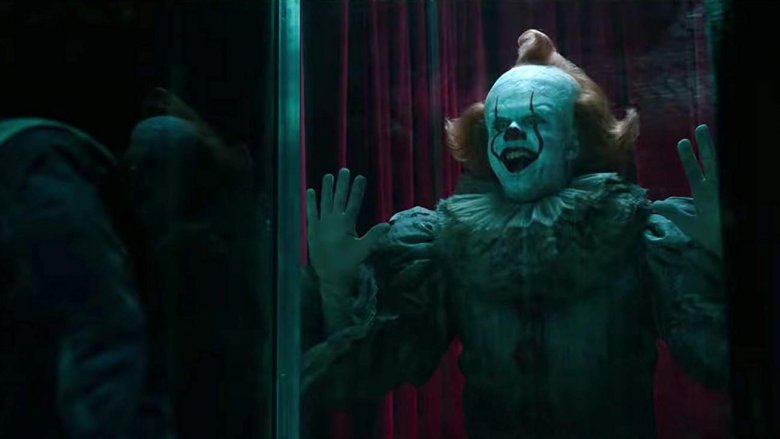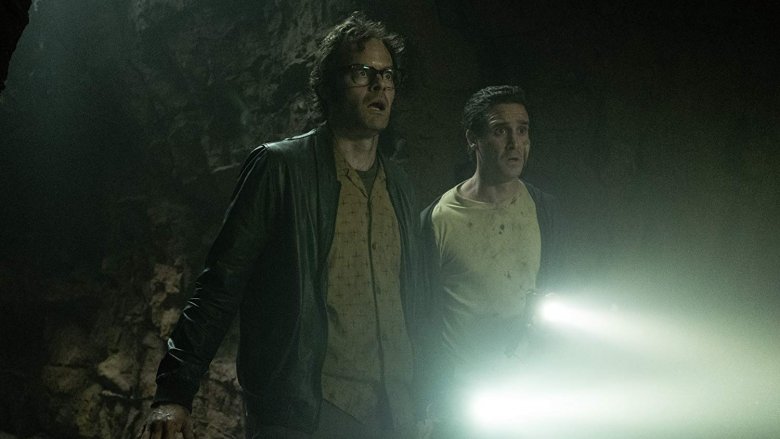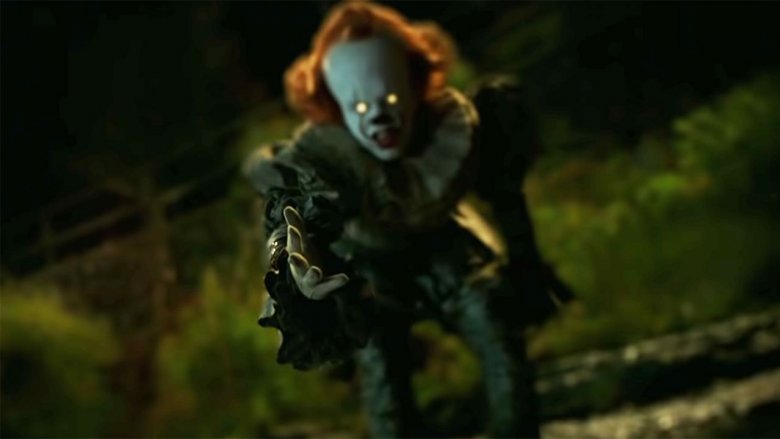5 Best And 5 Worst Things In It: Chapter Two
It's still strange how a story like Stephen King's It became such a big deal. This book is weird — oddly paced, not really well-received at the time, and culminating in a gross and cosmic ending that's practically unfilmable, it's a pretty bizarre thing for people to go so crazy for. But go crazy they have; the first movie in the couplet brought in a sensational $700 million, with the second one on its way to potentially matching that.
But just because something is popular doesn't mean it's good, much less flawless. With a Rotten Tomatoes score well below the original, the reception to the movie is trailing the first installment, which came out to a much more enthusiastic 86 percent of reviewers giving it the thumbs up. While audiences seem to be responding well, it's clear from the jump that there's a little more to complain about this time around. Here's our list of the highlights and lowlights — and yes, the Deadlights — of It: Chapter Two.
Best: Bill Hader as Richie Tozier
Saturday Night Live vet Bill Hader has really been showing off his dramatic chops in recent years, from his critically adored turn in HBO's complex Barry to his work in It: Chapter Two as the grown-up Richie Tozier. In the sequel, the Trashmouth has grown from a neighborhood nuisance to a national sensation, or at least something like that as an apparently well-known stand-up comic.
In his role as the older Richie, Hader builds on everything that Stranger Things' Finn Wolfhard laid down for the character in chapter one, so much so that it takes no effort to believe that he's that kid, just 27 years older. The movie suggests that despite any appearance of material success, he's not living up to his full potential — an intriguing step up from the radio DJ role he played in King's book, with the writing for the character also marking a notable improvement from the limp improvised jokes Harry Anderson strung together for the 1990 miniseries.
Worst: The chemistry
Despite any successes It: Chapter Two may have in improving on the old miniseries, the review consensus has been pretty consistent — the grown-up members of the Losers' Club don't really feel like old friends. Dialogue and the facts of the story aside, they all feel more like they're meeting each other for the first time, and it's an impression that never really goes away.
And before you go pointing out that the group members being distant towards each other was the whole point of It: Chapter Two, and that they were all amnesiacs slowly coming back to understanding their shared history — to the extent that the movie closes on an adult Mike Hanlon telling Bill Denbrough with aching sincerity that "I love you, man" — at no point does it actually feel like these people are connecting with each other. Everyone is frigid up until the point that they have to wrench the heart out of an ancient cosmic horror, when they all fight on the same side because no doy, that's what you're supposed to do.
One of the biggest strengths of the first It is the palpable sense of camaraderie that can be felt when the young cast interacts. Sparks fly in these scenes, as well as so, so many f-bombs. The kid scenes in the sequel still crackle with nostalgic energy, while the grown-up sequences all proceed as though they're dialogues among strangers killing time at the DMV.
Best: It: Chapter Two's casting in general
Despite those complaints, It: Chapter Two has assembled a fantastic cast. Seemingly willed into existence by the popular imagination — by which we mean Twitter, and probably these actors' publicists — the sequel is a coup of casting that nails a difficult task while making it look pretty easy. Casting the same part across generations is one of those things that you don't really notice unless it's done in a way that doesn't really work that well, and the It sequel does it so seamlessly that it even stops to flex about it, emphasizing the similarities between James Ransome and Jack Dylan Grazer as Eddie Kaspbarak in a show-offy transition shot.
The new cast's appeal isn't all about physical resemblance. James McAvoy deploys an American accent so convincing that you never question his Maine upbringing, and he also conveys the perfect level of frustration with his returning vocal stutter. Jay Ryan somehow manages to come off as an adult Ben Hanscom, one who seems to be aware of how hot he's become in adulthood, but knows he's supposed to be cool about it. Even Andy Bean in his brief turn as the adult Stan Uris manages to make his few scenes resonate by finding the right way to play his haunted nature without coming across as too melodramatic. Even though they don't come off as real childhood friends, they do all come off as real people.
Worst: Splitting up
Perhaps one reason why the cast of It: Chapter Two so rarely manages to feel like real friends is the fact the movie explicitly demands they stop spending time together at a critical point during their reunion. After returning to Derry, the group literally stands around and rationalizes how they need to split up to recover relics from their childhood on their own specific side missions, like it's the end of a video game and we need one last fetch quest before taking on the final boss.
This plot of needing to gather relics for the Ritual of Chüd is an invention of the movies, which stretches to come up with a good reason for the characters to spend time apart — something that happens in a more organic, meandering fashion in King's It book. As a result, we end up spending way too much of the movie watching the characters be isolated, facing their fears in an assembly line fashion that gets dull fast. Logically, the characters would probably want to stick together after realizing what Mike's told them is all real. Instead, the movie invents a reason for them to arbitrarily split up, not really because the story demands it, and more because the screenplay's structure does.
Best: It: Chapter Two's Chinese restaurant scene
One of the reasons why the cast's lack of chemistry or camaraderie is so frustrating has to do with the one scene featuring them all together that the movie 100 percent nails: the initial reunion sequence at the Jade of the Orient Chinese restaurant, which somehow really works wonders this time around.
In King's book, this scene is less of a fun hangout sequence and more of an exposition engine laying track for the plot to come, and the 1990 miniseries version of the scene is just weird, tonally removed from the rest of the movie and feeling very awkward and made-for-TV. But It: Chapter Two brings the scene to life with an electric energy, with the members of the Losers' Club seeming to come back in real time as the protagonists loosen up, both through their renewed proximity to each other and the power of alcohol.
The only place where this scene doesn't improve on the old miniseries or the book is the climactic invasion of It as demented fortune cookies, which jump up off the table and turn into CGI monstrosities that kind of all look like the horror movie equivalent of the Sonic trailer.
Worst: The CGI of It: Chapter Two
One of the most consistent sins of It: Chapter Two — aside from its over-reliance on jump scares and loud noises — is the overuse of way too much not-quite-there CGI during the movie's horror sequences. It almost feels like the movie overloads on creepy music and startling, monster-leaps-at-the-screen moments to make up for the fact that, on its own, a lot of this CGI stuff just isn't scary.
CGI creature effects work best in something like a lighthearted Avengers-style movie, when you want to buy into the comic book fiction of it all and let the movie get away with things that look less than realistic. But that's generally not how things work with horror, which gets its most effective scares out of keeping the viewer engaged and drawing them in to a nightmarish moment, making them believe — if even for just a second — that it's all real. When a supposedly horrific sight makes you think more about what's new on Xbox than the fact that you're gonna die one day, it makes the scares much less effective, and the movie they're in less capable of standing the test of time.
Best: The actual horror of It: Chapter Two
There are parts of It: Chapter Two in which the horror all really works. Critics have said that It: Chapter Two is less scary than its 2017 predecessor, and while this may be true by the time the Losers' Club is fighting Pennywise as a giant spider and defeating it by screaming the f-word, it's not really true for the entire movie. Indeed, some sequences of It: Chapter Two shiver with such palpable horror that they trounce anything the first movie put forward.
Despite all the child slayings, the first It movie had a tendency to feel more like a thrill ride than anything close to psychologically affecting. That's not the case for some of It: Chapter Two's most genuinely disturbing scenes, which include the vicious assault and killing of a young gay man at the beginning of the movie and Pennywise sickly manipulating and devouring a little girl underneath some Derry bleachers. (There's also the repulsive prelude to an assault on young Beverly by her abusive father, far more disturbing for its insinuations than what it actually shows.)
Real horror should do more than just startle you — it should make you feel nasty, and stick to you like some kind of filmy slime. Pennywise leaping out of the dark with his claws out might make you jump, but these are the sequences that stick with you in the nights that follow.
Worst: The length
Of course, there's a lot to remember about It: Chapter Two once you're done watching it, because the bare basic fact is that this sequel is a lot of movie. Like, too much movie. At 165 minutes, the sequel's runtime edges up toward Avengers: Endgame levels, but that movie was MCU Chapter Twenty-Two, not Oh-Two.
While the movie doesn't feel truly punishing on a first watch, it does feel every minute of its 165-minute length, and it doesn't really feel like an experience that digs deep enough into its themes or characters to really warrant that massive running time. So much of the movie is given over to catching the audience up on where the characters are in their lives, and then giving them each a protracted solo scare sequence, a structure that gets repetitive and tiresome. (It doesn't help that the movie then goes on to end what feels like eight times, a la The Lord of the Rings.)
Best: The crazy crap of It: Chapter Two
You can say a lot of things about Stephen King, but one thing you can't deny is that the dude has a big imagination. Potent, eerie, too-hot-for-TV imagination, to the tune of 1,138 pages of often insane storytelling. As a book, It is full of rich details and left-turn sequences that seem inspired, at least in part, by a lenient editor and a lot of cocaine.
It's to the credit of It: Chapter Two that the sequel incorporates so much of the novel's weirdest elements, presenting them completely straight and making the already strange story of a shapeshifting killer clown even weirder this time around. Though the two It movies leave plenty of the more bizarre elements of King's story out of the adaptation, it's admirable just how much corny crap the movie commits to getting into, especially when it doesn't really need to explain too much about what's going on in Derry at all. Once the movie starts running through weird things like the Ritual of Chüd and It's true form as the cosmic Deadlights, you know you're watching a movie with some goofball genre swagger. This is a story that trusts you to stay with it through every weird turn, up to and including the part when the Losers kill Pennywise by basically just hurting its feelings.
Worst: What it left out
Though It: Chapter Two is willing to go to some strange places when it comes to It's ancient cosmic origins, the movie doesn't exactly go whole hog with everything the book has to offer. And we're not just talking about the space turtle Maturin or its eternal position as a force of good against It's evil. No, there are plenty of other story aspects from King's thick novel that just don't get a lot of play here, from the way the mere presence of It is implied to bring out the evil in Derry's residents, to the wider lives of the grown-up Losers, whose loved ones play more into the resolution of the story in the book than the movie wants to get into. Another unexplored thread is how all of the Losers grew up to be successful after leaving Derry, with the sole exception of Mike, who kept his memories while missing out on material wealth.
One other notable loss is the instantly abandoned storyline of the grown-up Bev's abusive husband, who is given one scene to be a bad guy before she flees. This entire aspect of her life and character remains utterly unresolved, and it speaks to a general lack of thematic storytelling in It's second installment. If the first movie was about childhood and loss of innocence, the second movie is about... what, exactly? For all its length and bluster, It: Chapter Two isn't really about anything other than killing that clown.
